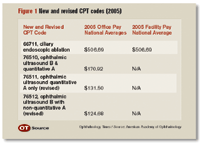Article
Ophthalmology sees 0.5% Medicare increase
The release of the 2005 Physician Fee Schedule includes an across-the-board increase of 1.5% to physicians as required under the Medicare Modernization Act (MMA).
The release of the 2005 Physician Fee Schedule includes an across-the-board increase of 1.5% to physicians as required under the Medicare Modernization Act (MMA).
However, for ophthalmology, that increase was limited to 0.5%-largely due to the Centers for Medicare and Medicaid Services (CMS) putting additional weight on medical liability expenses, or re-basing of professional liability relative value units (PLIRVU).
But the battle is not over. Much work continues to fix the flawed sustainable growth rate (SGR) formula.
"This flaw continues to affect ophthalmologists and all physicians, and its replacement with something based on the Medicare Economic Index is of the utmost importance to us," Dr. Rich said. "Fair reimbursement is the academy's number one priority in Washington."
H. Dunbar Hoskins Jr., MD, executive vice president of the AAO, is very vocal about what he sees as an increasingly frustrating effort to make lawmakers understand the harm they do to patients and physicians when they are cavalier about not allowing for proper growth of Medicare fees.
"The big thing hanging over us is the SGR," Dr. Hoskins said. "In fact, it is hanging over all of medicine. There are going to be cuts going forward for the next several years if we do not take action.
"Last year, Congress intervened with the MMA, by allowing the 1.5% increase," Dr. Hoskins said. "But, in essence, Congress has decided to hold physicians hostage to decreases and [small] increases. The result is the rapid abandoning of Medicare patients. That is an ongoing issue."
Last year, ophthalmologists were expecting a 4.5% cut in the fee schedule for 2004, but lobbying efforts by the AAO, American Society of Cataract and Refractive Surgery (ASCRS), and other specialty groups were instrumental in convincing federal lawmakers to fix the fee schedule.
President Bush signed the Medicare Prescription Drug and Modernization Act in the fall of 2003, which brought the 1.5% increase for 2004 and 2005. For ophthalmology, that meant an additional $258 million and increases in several codes.
Catherine Cohen, AAO's vice president for governmental affairs, said another cut at that time would have been devastating.
"The long-term problem is still not fixed and accomplishing that will require continuing [lobbying] of lawmakers so that they understand the importance of assuring quality medical care for Medicare patients," Cohen said.

More information about the new/revised codes-including a chart with the national average reimbursement for all ophthalmology codes-is available at http://www.aao.org/ and http://www.ascrs.org/
Among new provisions, the standard payment rate for most Part B drugs [e.g. verteporfin (Visudyne, Novartis Ophthalmics and QLT Inc.)] will be set at 106% of the Average Sales Price (ASP) and updated quarterly. The current estimated price is $1,369 but CMS is expected to update it this month, according to a statement issued by the AAO.
Newsletter
Don’t miss out—get Ophthalmology Times updates on the latest clinical advancements and expert interviews, straight to your inbox.




